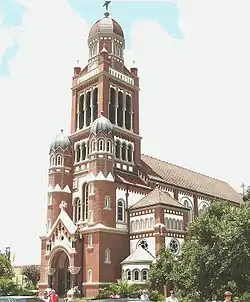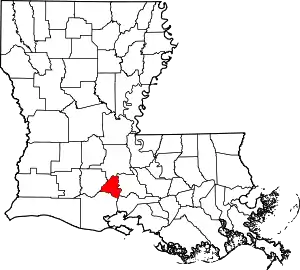Lafayette, Louisiana
Lafayette (/ˌlɑːfiːˈɛt, ˌlæf-/, French: [lafajɛt]) is a city in and the parish seat of Lafayette Parish, Louisiana,[4] located along the Vermilion River in the southwestern part of the state. The city of Lafayette is the fourth-largest in the state, with a population of 126,185 according to 2019 U.S. Census estimates.[3] It is the principal city of the Lafayette metropolitan statistical area, with a 2015 estimated population of 490,488. The larger trade area or combined statistical area of Lafayette-Opelousas-Morgan City CSA was 627,146 in 2015.[5] Its nickname is "The Hub City".
Lafayette, Louisiana
Ville de Lafayette, Louisiane | |
|---|---|
City | |
| City of Lafayette | |
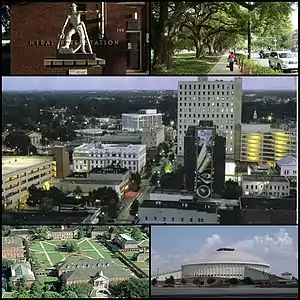 From upper left: statue in front of downtown fire station, oak-lined street in the university district, Downtown Lafayette, Cajundome, and University of Louisiana at Lafayette quad | |
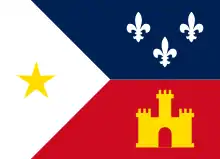 Flag | |
| Nickname(s): The Hub City | |
| Motto(s): The Heart of Cajun Country | |
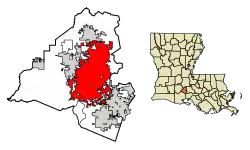 Location of Lafayette in Lafayette Parish, Louisiana | |
 Location of Lafayette in Louisiana | |
| Coordinates: 30°13′N 92°2′W | |
| Country | United States |
| State | Louisiana |
| Parish | Lafayette |
| Founded | 1821 as Vermilionville |
| Renamed | 1884 as Lafayette |
| Founded by | Jean Mouton |
| Named for | General Gilbert du Motier, Marquis de Lafayette |
| Government | |
| • Type | Consolidated City-Parish |
| • Mayor-President | Josh Guillory (R) |
| Area | |
| • City Total | 55.65 sq mi (144.13 km2) |
| • Land | 55.57 sq mi (143.92 km2) |
| • Water | 0.08 sq mi (0.20 km2) auto% |
| • Metro | 5,252 sq mi (13,600 km2) |
| Elevation | 36 ft (11 m) |
| Population | |
| • City Total | 120,623 |
| • Estimate (2019)[3] | 126,185 |
| • Rank | US: 214th |
| • Density | 2,270.78/sq mi (876.75/km2) |
| • Urban | 252,720 (US: 148th) |
| • Metro | 490,488 (US: 108th) |
| • CSA | 627,146 (US: 77th) |
| Demonym(s) | Lafayettiens |
| Time zone | UTC−6 (CST) |
| • Summer (DST) | UTC−5 (CDT) |
| ZIP codes | 70501–9, 70593, 70596, 70598 |
| Area code(s) | 337 |
| FIPS code | 22-40735 |
| Website | www.lafayettetravel.com |
History
The Attakapas Native Americans inhabited this area at the time of the first European encounter. French colonists founded the first European settlement, Petit Manchac, a trading post along the Vermilion River.[6] In the mid-to-late eighteenth century, numerous Acadian refugees settled in this area, after being expelled from Canada after Great Britain defeated France in the Seven Years' War. They intermarried with other settlers, forming what became known as Cajun culture, which maintained use of the French language and adherence to the Roman Catholic Church.
Jean Mouton, an Acadian settler, donated land to the Catholic Church for construction of a small Catholic chapel at this site. In 1824, this area was selected for the Lafayette Parish seat and was named Vermilionville, for its location on the river. In 1836, the Louisiana Legislature approved its incorporation.
The area was initially developed by Europeans for agriculture, primarily sugar plantations, which depended on the labor of numerous enslaved Africans and African Americans. They made up a large percentage of the antebellum population.[6] According to U.S. Census data in 1830, some 41% of the population of Lafayette Parish was enslaved.[7] By 1860, the enslaved population had increased to 49.6%. Some free people of color lived in Lafayette Parish, as well; they made up 3%, to a low of 2.4% between 1830 and 1860.
In 1884, Vermilionville was renamed for General Lafayette, a French aristocrat who had fought with and significantly aided the Continental Army during the American Revolutionary War.[8] The city and parish economy continued to be based on agriculture into the early 20th century. After the Civil War, most of the labor was done by freedmen, who worked as sharecroppers. From the 1930s, mechanization of agriculture began to reduce the need for farm workers.[9]
In the 1940s, after oil was discovered in the parish, the petroleum and natural gas industries expanded to dominate the economy.
Lafayette is considered to be the center of Acadiana, the area of Cajun culture in the state. It is also a center of Louisiana Creole culture. The Cajun culture developed among settlers here over the decades and centuries following the relocation of Acadians after their expulsion by the British. A strong Louisiana Creole influence also is in the area, as this mixed-race population became landowners and businesspeople.[10]
Etymology
Lafayette is named after Marquis de Lafayette. Little is known about early settlements or if the area had a different name prior to European colonization.
Geography
Lafayette is located at 30°13′N 92°2′W (30.2139, −92.0294)[11] and has an elevation of 36 feet (11.0 m).[12] According to the United States Census Bureau, the city has a total area of 49.2 square miles (127 km2), of which 49.1 square miles (127 km2) are land and 0.1 sq mi (0.26 km2) (0.19%) is covered by water.
Lafayette is located on the West Gulf Coastal Plain. The site was part of the seabed during the earlier Quaternary period. During this time, the Mississippi River cut a 325-foot-deep (99 m) valley between what is now Lafayette and Baton Rouge. This valley was filled and is now the Atchafalaya Basin. Lafayette is located on the western rim of this valley.
This is part of the southwestern Louisiana Prairie Terrace; it is higher and not made of wetlands like much of the surrounding areas to the south and west of Lafayette. Lafayette does not suffer significant flooding problems, outside of local flash flooding. Lafayette has developed on both sides of the Vermilion River. Other significant waterways in the city are Isaac Verot Coulee, Coulee Mine, Coulee des Poches, and Coulee Ile des Cannes, which are natural drainage canals that lead to the Vermilion River.[13]
Climate
Lafayette's climate is described as humid subtropical using Köppen climate classification. It has year-round precipitation, especially during summertime. Lafayette's highest temperature was 107 °F (42 °C); it has hot, moist summers and warm, damp winters.
| Climate data for Lafayette, Louisiana | |||||||||||||
|---|---|---|---|---|---|---|---|---|---|---|---|---|---|
| Month | Jan | Feb | Mar | Apr | May | Jun | Jul | Aug | Sep | Oct | Nov | Dec | Year |
| Record high °F (°C) | 89 (32) |
87 (31) |
93 (34) |
93 (34) |
98 (37) |
106 (41) |
107 (42) |
103 (39) |
101 (38) |
96 (36) |
92 (33) |
89 (32) |
107 (42) |
| Average high °F (°C) | 64 (18) |
66 (19) |
72 (22) |
79 (26) |
86 (30) |
91 (33) |
92 (33) |
92 (33) |
89 (32) |
82 (28) |
72 (22) |
64 (18) |
79 (26) |
| Average low °F (°C) | 43 (6) |
45 (7) |
51 (11) |
57 (14) |
64 (18) |
70 (21) |
72 (22) |
72 (22) |
67 (19) |
57 (14) |
48 (9) |
43 (6) |
57 (14) |
| Record low °F (°C) | 10 (−12) |
2 (−17) |
24 (−4) |
32 (0) |
42 (6) |
53 (12) |
57 (14) |
53 (12) |
41 (5) |
27 (−3) |
21 (−6) |
14 (−10) |
6 (−14) |
| Average precipitation inches (mm) | 5.0 (130) |
4.5 (110) |
4.2 (110) |
4.3 (110) |
4.8 (120) |
5.5 (140) |
6.7 (170) |
5.6 (140) |
4.1 (100) |
3.3 (84) |
3.9 (99) |
5.4 (140) |
57.3 (1,460) |
| Source: Weatherbase[14] | |||||||||||||
Demographics
| Historical population | |||
|---|---|---|---|
| Census | Pop. | %± | |
| 1860 | 498 | — | |
| 1870 | 777 | 56.0% | |
| 1880 | 815 | 4.9% | |
| 1890 | 2,106 | 158.4% | |
| 1900 | 3,314 | 57.4% | |
| 1910 | 6,392 | 92.9% | |
| 1920 | 7,855 | 22.9% | |
| 1930 | 14,635 | 86.3% | |
| 1940 | 19,210 | 31.3% | |
| 1950 | 33,541 | 74.6% | |
| 1960 | 40,400 | 20.4% | |
| 1970 | 68,908 | 70.6% | |
| 1980 | 80,584 | 16.9% | |
| 1990 | 94,440 | 17.2% | |
| 2000 | 110,257 | 16.7% | |
| 2010 | 120,623 | 9.4% | |
| 2019 (est.) | 126,185 | [3] | 4.6% |
| U.S. Decennial Census[15] | |||
As of the census[16] of 2010, 120,623 people, 43,506 households, and 27,104 families were residing in the city. The population density was 2,316.7 people per square mile (894.5/km2). The 46,865 housing units averaged 984.7 per square mile (380.2/km2). The racial makeup of the city was 68.23% White, 28.51% African American, 0.25% Native American, 1.44% Asian, 0.60% from other races, and 0.97% from two or more races. Hispanics or Latinos of any race were 7.88% of the population. In 2010, 84.2% of the population over the age of five spoke only English at home, while 11.5% of the population spoke French.[17]
Of the 43,506 households, 31.3% had children under the age of 18 living with them, 43.9% were married couples living together, 14.6% had a female householder with no husband present, and 37.7% were not families. About 29.4% of all households were made up of individuals, and 8.0% had someone living alone who was 65 years of age or older. The average household size was 2.43, and the average family size was 3.07.
In the city, the age distribution was 25.1% under 18, 13.3% from 18 to 24, 29.5% from 25 to 44, 20.9% from 45 to 64, and 11.2% who were 65 years of age or older. The median age was 33 years. For every 100 females, there were 93.1 males. For every 100 females age 18 and over, there were 90.9 males.
The median income for a household in the city was $35,996, and for a family was $47,783. Males had a median income of $37,729 versus $23,606 for females. The per capita income for the city was $21,031. About 11.6% of families and 16.3% of the population were below the poverty line, including 18.3% of those under age 18 and 14.5% of those age 65 or over.
Education and healthcare
Primary and secondary schools
Public schools
The public schools in the parish are run by the Lafayette Parish School System (LPSS). The system has 45 schools: 25 elementary schools, 12 middle schools, and eight high schools. The LPSS offers nine career academies at the high-school level, school curricula designed to prepare students in certain career fields.[18]
Private schools
Lafayette is home to a large Roman Catholic population. They support many private parochial schools, including kindergarten through 12th grade.
Universities and colleges
Lafayette has one university, one community college, and two vocational colleges.
The University of Louisiana at Lafayette is part of the University of Louisiana System. It is a national research institution, home to more than 18,000 students, over 100 programs, and home of the Louisiana Ragin' Cajuns. It is the second-largest university in the state. Schools and colleges related to the institution have been located in Lafayette since 1898.
One of the newest college systems in Louisiana, South Louisiana Community College (SLCC), is headquartered in Lafayette. SLCC partnered with Acadian Ambulance to form the National EMS Academy, which offers EMT-Basic and EMT-Paramedic certification. SLCC is part of the Louisiana Community and Technical College System.[19] Louisiana Technical College (Lafayette campus) is part of the Louisiana Technical College System,[20] which in turn is part of the Louisiana Community and Technical College System. It offers associate degrees in several fields.[21] is a vocational school that offers a few bachelor's-degree programs, many associate-degree programs, and a few diploma programs.
It is also home to the Lafayette campus of the Academy of Interactive Entertainment, a technical college that specializes in video game programming, art and animation, and SFX.
Public library system
Healthcare
Lafayette's major healthcare facilities are:
- Lafayette General Medical Center
- Lafayette General Surgical Hospital
- Lafayette Surgical Specialty Hospital
- University Hospital and Clinics (formerly University Medical Center, and now part of the LGH system)- As of October 1, 2020 University Hospitals and Clinics merged with Ochsner Medical Center to become Ochsner University Hospitals and Clinics.
- Women's and Children's Hospital
- Lafayette General Orthopaedic Hospital (formerly the Regional Medical Center of Acadiana)
- Our Lady of Lourdes Regional Medical Center
- Heart Hospital of Lafayette
- Park Place Surgical Hospital
- Cardiovascular Institute of the South
Government and politics
See also Notable local politicians
Since the consolidation of city and parish governments in 1992, Lafayette's chief executive is known as the mayor-president. Republican Josh Guillory was elected to this office most recently.[22]
Some residents did not like the consolidated government, but in 2011, parish voters soundly rejected a proposal to separate parish and city governments. Under consolidation, the City of Lafayette and Parish of Lafayette have a common representative body and executive officer. Public works and other services, such as land use and plat review, are operated by the Lafayette Consolidated Government to serve the City of Lafayette and unincorporated areas of Lafayette Parish, and by contract some of the area municipalities. Zoning rules apply only within the city and unincorporated areas of Lafayette Parish.[23]
Some neighboring municipalities have adopted their own planning and zoning protocols. The suburban and rural cities and towns maintain independent city councils, local executives, police and fire departments, and other public services. The LPSS operates independently of any municipality, and its jurisdiction is coterminous with the Parish of Lafayette.[24]
Lafayette is also home to a regional office of the Louisiana Department of Environmental Quality, and the headquarters of the Council for the Development of French in Louisiana, the state agency that oversees preservation and documentation of Louisiana French for tourism, economic development, culture, education, and the development of international relations with other Francophone regions and countries.[25]
Law enforcement
Lafayette is served by four local police agencies:
- Lafayette City Police – the main municipal police department of the city
- Lafayette Parish Sheriff's Office – the parish-level police agency
- University Police - the police force of the University of Louisiana at Lafayette
- Lafayette City Marshal
Note: City Police and Parish Sheriff's office were not combined during consolidation.
Military
Lafayette is home to the National Guard headquarters of the 256th Infantry Brigade, a military unit of more than 3,000 soldiers. The unit served in Iraq in 2004–2005. The brigade was deployed again in January 2010.[26]
Until 2014, Lafayette was also home to the United States Marine Corps Reserve Unit, F. Co. Anti-Terrorism Battalion commanded by Captain Cole Clements. This unit went on several deployments, many related to the Iraq War. In 2014, F. Co. Anti-Terrorism Battalion was decommissioned, to be replaced with H&S Co. Det. 4 4th Tanks Tow and Scouts, 4th MARDIV.[26]
Utilities
- Electricity, water, and waste water
Lafayette is served by Lafayette Utilities System (LUS), a city-parish government-run, publicly owned utility company. This water and electricity utility was created in 1897.[27][28]
Both electricity and water services have been continuously provided by LUS to the residents of the City of Lafayette since that time. LUS has expanded to provide electricity, drinking water, and sewage treatment throughout the City of Lafayette, and to some unincorporated parts of Lafayette Parish. LUS also provides bulk sales to the water systems of most surrounding municipalities.
In 2009, LUS installed infrastructure for a fiber telecommunications network. Called LUSFiber, the network provides digital cable, telephone service, and high-speed internet to all households in Lafayette.[29]
- Natural gas
Natural gas service is supplied by Atmos Energy.
- Telephone
Local land-line telephone service is provided by AT&T. Cox Communications and LUS Fiber provide Voice over Internet Protocol phone service.
- Television
Cable television service in Lafayette is provided by Cox Communications. LUS provides FTTH video services through LUSFiber. DirecTV and Dish Network both include Lafayette TV stations in their local packages.
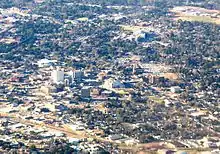

Culture and contemporary life
Cultural organizations and institutions
Cultural organizations include the Acadiana Symphony Orchestra and Conservatory of Music, Chorale Acadienne, Lafayette Ballet Theatre and Dance Conservatory, the Lafayette Concert Band, and Performing Arts Society of Acadiana; as well as the Paul and Lulu Hilliard University Art Museum and the Acadiana Center for the Arts.
The 2018 television film, The Christmas Contract, set in Lafayette, features many Cajun Christmas customs. In the story line, Jolie Guidry (Hilarie Burton) dreads returning to her home town when she learns that her former boyfriend, Foster Broussard (Hunter Burke) will be present at social gatherings with his new love interest. Jolie persuades Jack (Robert Buckley) to be her "contracted" escort in Lafayette. Then romance blossoms between Jolie and Jack. Bruce Boxleitner plays Jolie's father, Tim.[30]
Sports
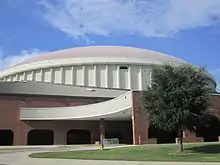
Lafayette is home to the Louisiana Ragin' Cajuns, the athletic teams of the University of Louisiana at Lafayette. It is home to the Bayou Hurricanes, a semiprofessional football team that plays at Clark Field. Between 1995 and 2005, Lafayette was home to the Louisiana IceGators ECHL hockey team. In 2009, the IceGators returned as a member of the Southern Professional Hockey League until 2016. Also from 2009 to 2012, Lafayette was home to the Lafayette Wildcatters of the Southern Indoor Football League. It is also home to the Lafayette Bayou Bulls, a semipro football program started in 2003. Lafayette is also home to the Acadiana Cane Cutters, a summer-league baseball team. The team plays its games at Fabacher Field and is a member of the Texas Collegiate League. The Lafayette SwampCats (1997–1999) and Lafayette Swamp Cats (2000–2004) soccer teams played in the city. The Cajun Soccer Club of the Gulf Coast Premier League was founded in 2013. The Acadiana Rollergirls of the Women's Flat Track Derby Association is a roller derby league in Lafayette.
The Lafayette area is home to multiple sports venues: Blackham Coliseum, Cajundome, Cajun Field, Earl K. Long Gymnasium, Evangeline Downs, and Planet Ice Skating and Hockey Arena.
Lafayette was home to minor-league baseball teams in various seasons from 1907 to 2000. Lafayette was an affiliate of the St. Louis Browns 1936–1941, Chicago Cubs (1955-1957) and San Francisco Giants (1975-1976). The Lafayette Browns (1907), Lafayette Hubs (1920), Lafayette White Sox (1934-1942), Lafayette Bulls (1948-1953), Lafayette Oilers (1954-1957), Lafayette Drillers (1975-1976) and Bayou Bullfrogs (1998-2000) all played in Lafayette. The teams were members of the Gulf Coast League (1907), Louisiana State League (1920), Evangeline League (1934-1942, 1948–1953, 1954-1957), Texas League (1975-1976) and Texas-Louisiana League (1998-2000). Lafayette teams played at Parkdale Park (1934-1942), Clark Field (1945-1957, 1975-1976) and Tigue Moore Field (1998-2000).[31][32][33]
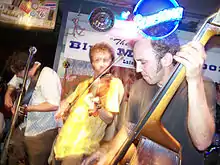
Media
Print
- The Daily Advertiser, daily Gannett broadsheet-style newspaper
- 337 magazine, regional lifestyle publication
- The Advocate, daily newspaper with local coverage from Baton Rouge
- The Independent, monthly locally owned newspaper (compact style)
- The Times of Acadiana, weekly Gannett tabloid format
- AcadianaMoms magazine
- Acadiana Gazette, weekly newspaper published by Ron Gomez
- Acadiana Profile magazine, established in 1968 by Robert Angers
- The Vermilion, University of Louisiana at Lafayette student newspaper
- Acadiana Catholic, monthly Catholic magazine of the Lafayette Diocese
Television
Lafayette is served by Cox Communications and by LUS's LUSFiber.[34]
Lafayette is home to:
- KATC: 3.1, Cable 5 – (ABC); 3.2, Cable 10 (The CW, 3.3 Grit Cox Cable 124)
- KLFY-TV 10.1, Cable 11 – (CBS); 10.2, Cable 131 (GetTV); 10.3 Cable 70 (Ion Television)
- KADN-TV 15.1, Cable 6 – (Fox); 15.3, Cable 13 (MyNetworkTV)
- KDCG-CD 22.1, Cable 9 – (H&I)
- KLAF-LD 46 / 15.2, Cable 3 – (NBC)
- KLWB, 50.1, Cable 23 – (MeTV)
- KLPB-TV, 24.1, Cable 12/122/123 – (PBS) Louisiana Public Broadcasting
- KXKW-LD 32.1 (Stadium), 32.2 – (AntTV)
- KAJN-CD 40.1, Cable 97 – Family Vision
Lafayette is also served by:
- KPLC-TV, 7.1 (NBC 7.2 CW, 7.3 Bounce TV, 7.4 Grit), located in nearby Lake Charles
- WVLA-TV, 33.1 (NBC, 33.2 Laff, 33.3 Ion Television), located in nearby Baton Rouge
- WBRZ, 2.1, Cable 17, (ABC), located in Baton Rouge
- WAFB, 9.1, (CBS), located in Baton Rouge
- KALB-TV, 5.1, 5.2 (NBC & CBS), located in Alexandria
- WGMB-TV, 44.1, Fox Broadcasting Company, located in Baton Rouge
Radio
See List of Lafayette radio stations for full list
Popular radio stations in Lafayette:
- KYBG (FM), 102.1 – BIG102.1 Classic Hits (0102.1)
- KFTE (FM), Classic Rock 105.1 – Classic Rock (105.1)
- KMDL(FM), 97.3 The Dawg – Country music, New Orleans Saints radio network affiliate (97.3)
- KPEL (AM), ESPN 1420 – Sports Radio (1420)
- KPEL-FM (FM), NewsRadio 96.5 – News radio (96.5)
- KHXT (FM), Hot 107.9 – Rhythmic Contemporary (107.9)
- KZJM (LPFM), The People Station – Urban Contemporary (92.7) – air date: 2005
- KROF (AM), 960 The Gator, Cajun Variety (960)
- KTDY (FM), 99.9 KTDY, Adult Contemporary (99.9)
- KSMB (FM), 94.5 KSMB, Top 40 (CHR) (94.5)
- KNEK-FM (FM), Magic 104.7, Urban AC (104.7)
- KRRQ (FM), Q 95.5, Urban Contemporary (95.5)
- KXKC (FM), 99.1 KXKC, country music (99.1)
- KYFJ (FM), Rock 93.7, Contemporary Christian (93.7)
- KRVS (FM), Public Radio for Acadiana, World Ethnic (88.7)
- KAJN-FM (FM), Agape Radio, Contemporary Christian (102.9)
- KIKL (FM), Positive and Encouraging K-Love, Contemporary Christian (90.9)
- KLWB-FM (FM),103.7 The Game, NBC Sports Radio
- KCKR-FM (FM), Sonlife Radio, Christian Talk & Gospel Music (91.9)
- KYMK-FM (FM), Radio Lafayette Adult Alternative (106.3)
Places of interest
- Acadiana Center for the Arts
- Acadian Village is a reconstructed Cajun bayou community (of moved and reassembled authentic buildings) and has a representative collection of Cajun furnishings.
- Alexandre Mouton House Museum – a historic house museum, the home of Louisiana's first Democratic governor, Alexandre Mouton; contains a collection of antiques, historical documents, and old Mardi Gras costumes
- Borden's Ice Cream – the last Borden's Ice Cream location in the United States
- Caillouet House
- Children's Museum of Acadiana
- Cité des Arts
- Cypress Lake is a two-acre swamp-like lake in the heart of the UL campus that is a unique university landmark and a habitat for native irises, alligators, turtles, birds and fish, as well as a hangout for students and a point of interest for tourists visiting the city.
- Downtown Lafayette
- Girard Park
- Heymann Center – performing arts center
- Acadian Cultural Center of the Jean Lafitte National Historical Park and Preserve
- Katog Choling Tibetan Cultural Center
- Lafayette Natural History Museum & Planetarium
- Louisiana Immersive Technologies Enterprise (LITE) – a 70,000-square-foot facility at the Research Park; owns the world's first six-sided, digital virtual reality cube as well as the world's largest digital 3-D auditorium
- Mouton Plantation Bed and Breakfast – originally built by Governor Charles Mouton (1797-1848), son of Lafayette's founder, Jean Mouton (1754-1834)
- Paul and Lulu Hilliard University Art Museum
- Vermilionville Historic Village – one of the world's largest Cajun and Creole living history museums, with seven restored historic structures from the 1765–1890 era
- Zoosiana – located nearby in Broussard
Events
- Cajun Heartland State Fair – an eleven-day state fair held on the grounds of the Cajundome and Convention Center
- Festivals Acadiens et Creoles – an annual collection of festivals celebrating Cajun and Creole cultures
- Festival International de Louisiane – an annual international festival of arts and music, celebrating Lafayette and the surrounding area's French heritage
- Le Festival de Mardi Gras à Lafayette – the second largest Mardi Gras celebration in Louisiana
Transportation
- Air: Lafayette Regional Airport (LFT) is located on US Highway 90, on the southeast side of the city with daily scheduled passenger airline services to Houston, Dallas/Fort Worth, and Atlanta. Charter services depart Lafayette Regional as well as helicopter services and cargo jets.
- Interstate Highway: I-10 and I-49 (Lafayette serves as I-49's southern terminus, at its intersection with I-10.)
- Passenger rail: The Amtrak Sunset Limited offers service three days a week from New Orleans, Louisiana and Los Angeles, California with selected stops in Louisiana, Texas, New Mexico, Arizona and California. Connections are available in New Orleans to Chicago and to the East Coast via Atlanta. Service eastward to Orlando, Florida remains suspended in the aftermath of Hurricane Katrina.
- Intercity passenger bus: Greyhound operates a station downtown on Lee Avenue with destinations east and west on I-10, north on I-49 and southeast on US Hwy 90
- Public transit: Lafayette Transit System (formerly City of Lafayette Transit (COLT)) provides bus service. Public transportation is provided only within Lafayette City Limits.
- Bicycle facilities: There are certain areas within the city of Lafayette dedicated to growing into a bicycle-friendly community. The Lafayette MPO Bicycle Subcommittee meet once a month and has developed long-term goals for bicycling in the area. BikeLafayette is the area's bicycle advocacy organization which is very active in promoting bicycle awareness, safety, and education in Acadiana. TRAIL is an organization that promotes bicycling, canoeing, and pedestrian activities. Right now Lafayette has a growing number of dedicated commuter and recreational bicycling facilities, including a bicycle lane on each side of Johnston Street from UL-Lafayette area at Lewis Street to near Ambassador Caffery, ending at Ridge Road. Henderson Levee has opened a 55-mile trail, and there is a mountain bike park in Acadiana Park. UL-Lafayette has installed an off-road paved bicycle path beginning at its Horticultural Center on Johnston Street extending up Cajundome Boulevard to Eraste Landry Road. A number of out of use bicycle/pedestrian sidewalk paths remain from the 1970s and 1980s but are unsigned. A recreational trail extending from Downtown Lafayette into the Cypress Island region of Saint Martin Parish is under development. This path will connect neighboring Breaux Bridge and Saint Martinville with Lafayette.
- Main road arteries: U.S. Routes 90 (co-signed with Evangeline Thruway, Mudd Avenue and Cameron Street within the city limits) and U.S. Route 167 (co-signed with I-49, Evangeline Thruway and Johnston Street). Ambassador Caffery Parkway, named for Jefferson Caffery, serves as a partial loop connecting I-10 at Exit 100 on the west and US 90 on the south. Other arterial roads include Verot School Road (LA 339), West Congress Street, Kaliste Saloom Road (LA 3095), Ridge Road, Carmel Drive/Breaux Bridge Highway (LA 94), University Avenue (LA 182), Pinhook Road (LA 182), Camellia Boulevard, Guilbeau Road, Moss Street, Willow Street, Louisiana Avenue, Pont Des Mouton Road, Eraste Landry Road, and South College Road.
Notable people
- Danneel Ackles, actress and model
- Liz Carmouche, mixed martial artist
- Irvin Castille, baseball player in the Negro leagues
- Michael Ray Charles, Artist, African-American painter
- Jermall Charlo, boxer
- Jermell Charlo, boxer and identical twin to Jermall Charlo
- Daniel Cormier, mixed martial artist and former Olympic wrestler
- Lauren Daigle, Grammy Award-winning contemporary Christian singer / recording artist
- Lawrence Duhé, early jazz clarinetist and bandleader
- Armand Duplantis, Swedish-American world record pole vaulter
- Ron Guidry, former Major League Baseball player (New York Yankees)
- Danneel Harris, American actress and model
- Hunter Hayes, country musician
- Alan Jouban, mixed martial artist
- Angela Kinsey, actress
- Sonny Landreth, blues musician
- Ann McBride Norton (1944–2020), activist and business executive
- Kim Perrot (1967–1999), pro basketball player
- Addison Rae, TikToker and social media personality[35]
- Dax Riggs, musician
- Chanda Rubin, former tennis player
- Keith Thibodeaux, musician and former child actor
- Dustin Poirier, mixed martial artist[36]
Sister cities
Lafayette has seven sister cities:[37]
 Le Cannet, Alpes-Maritimes, Provence-Alpes-Côte d'Azur, France (twinned May 26, 1967)
Le Cannet, Alpes-Maritimes, Provence-Alpes-Côte d'Azur, France (twinned May 26, 1967).svg.png.webp) Longueuil, Quebec, Canada (twinned December 3, 1968)
Longueuil, Quebec, Canada (twinned December 3, 1968).svg.png.webp) Moncton, New Brunswick, Canada (twinned October 19, 1971)
Moncton, New Brunswick, Canada (twinned October 19, 1971) Poitiers, Vienne, Nouvelle-Aquitaine, France (twinned April 22, 1975)
Poitiers, Vienne, Nouvelle-Aquitaine, France (twinned April 22, 1975).svg.png.webp) Namur, Wallonia, Belgium (twinned June 19, 1979)
Namur, Wallonia, Belgium (twinned June 19, 1979)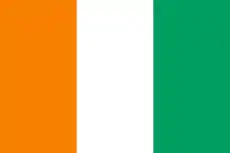 Agnibilékrou, Ivory Coast (twinned October 5, 1999)
Agnibilékrou, Ivory Coast (twinned October 5, 1999) Centla, Mexico (twinned November 4, 2013)
Centla, Mexico (twinned November 4, 2013)
Six intersections in the downtown area are each named after one of its sister cities.
See also
- List of people from Lafayette, Louisiana
- Youngsville, Louisiana
References
- "2019 U.S. Gazetteer Files". United States Census Bureau. Retrieved July 25, 2020.
- "U.S. Census website". United States Census Bureau. Retrieved December 7, 2016.
- "Population and Housing Unit Estimates". Retrieved May 21, 2020.
- "Find a County". National Association of Counties. Retrieved 2011-06-07.
- "Population Estimates". United States Census Bureau. Archived from the original on October 19, 2016. Retrieved December 7, 2016.
- Martin, Michael (2007). Historic Lafayette: An Illustrated History of Lafayette & Lafayette Parish. San Antonio, Texas: Historical Publishing Network. pp. 5–7, 10, 11. ISBN 9781893619760.
- Written at Duff Green. Abstract of the Fifth Census of the United States (PDF). Washington DC: House of Representatives, United States of America. 1832.
- Niles' Weekly Register, BALTIMORE, June 26, 1824; LAFAYETTE
- Blackmon, Douglas. Slavery by Another Name.
- Dormon, James (September 1992). "Louisiana's "Creoles of Color": Ethnicity, Marginality, and Identity". Social Science Quarterly. 73 (3): 615–626.
- "US Gazetteer files: 2010, 2000, and 1990". United States Census Bureau. February 12, 2011. Retrieved 2011-04-23.
- "US Board on Geographic Names". United States Geological Survey. October 25, 2007. Retrieved 2008-01-31.
- "Official Drainage Map Lafayette Parish" (PDF). June 5, 2018. Retrieved 2020-02-01.
- "Historical Weather for Lafayette, Louisiana, United States of America". Weatherbase.com. 2009. Retrieved 2009-07-20.
- "Census of Population and Housing". Census.gov. Retrieved June 4, 2015.
- "U.S. Census website". United States Census Bureau. Retrieved 2008-01-31.
- "Archived copy". Archived from the original on May 25, 2009. Retrieved 2013-08-07.CS1 maint: archived copy as title (link)
- "{ Career Academies : LPSS : Lafayette Parish School System }". Lpssonline.com. August 30, 2015. Retrieved 2017-07-20.
- Gomez, Nancy (May 19, 2008). "La. Specialized Language Course Aims To Knock Down Barriers". Community College Week. 20 (19): 13.
- "Archived copy". Archived from the original on August 4, 2009. Retrieved 2009-07-20.CS1 maint: archived copy as title (link)
- "Remington College in Lafayette – Lafayette Technical School". Remingtoncollege.edu. Retrieved 2017-07-20.
- "Guillory Wins Mayor-President Race". theadvertisor.com. Retrieved 2020-02-01.
- Brand, Anna; Villavaso, Stephen (Spring 2011). "REVISITING PALERMO: THE TWENTIETH ANNIVERSARY OF LOUISIANA'S LANDMARK LAND USE RIGHTS AND ZONING DECISION AND ITS LEGACY FOR PLANNING IN LOUISIANA". Loyola Law Review. 57 (1): 113–133.
- "Intergovernmental Agreement". Webcache.googleusercontent.com. Retrieved 2017-07-20.
- ""Archived copy". Archived from the original on 2013-07-07. Retrieved 2013-07-08.CS1 maint: archived copy as title (link)." CODOFIL. Retrieved on July 8, 2013.
- "National Guard Units Alerted for Iraq Duty". Army Magazine. 54 (4): 64–66. April 2004.
- "Water and Light: A model plant nearly completed – Everything works without a hitch." Lafayette Gazette, 5 March 1898, page 1.
- LUS (1953) Comprehensive Engineering Report as of October 31, 1952. Prepared by R.W. Beck and Associates for the City of Lafayette Louisiana Utilities System.
- "Archived copy". Archived from the original on April 20, 2009. Retrieved 2009-07-21.CS1 maint: archived copy as title (link)
- "The Christmas Contract (television film)". Internet Movie Database. Retrieved November 23, 2018.
- "Lafayette Drillers - BR Bullpen". www.baseball-reference.com.
- "Bayou Bullfrogs - BR Bullpen". www.baseball-reference.com.
- "Lafayette, LA - BR Bullpen". www.baseball-reference.com.
- "Home". LUS Fiber. Retrieved 2017-07-20.
- Kim, Yerin (2020-03-20). "Everything You Need to Know About TikTok Star Addison Rae". Seventeen. Retrieved 2020-04-03.
- Allentuck, Danielle (2021-01-22). "Five things to know about Lafayette native Dustin Poirier before his fight with Conor McGregor". Daily Advertiser. Retrieved 2021-02-01.
- "Lafayette's six sister cities". Archived from the original on January 6, 2010. Retrieved October 16, 2009.
External links
| Wikimedia Commons has media related to Lafayette, Louisiana. |
